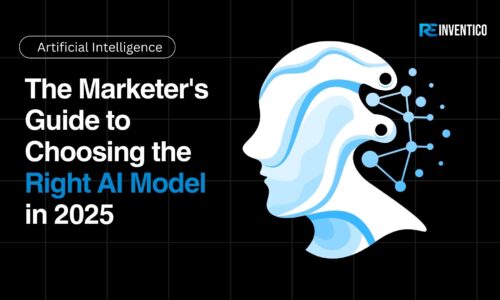Remember when “artificial intelligence” in marketing felt like a distant, sci-fi concept, a whispered promise of a far-off future? Fast forward to mid-2025, and AI isn’t just knocking on the door; it’s already inside, meticulously optimizing campaigns, crafting personalized experiences, and fundamentally reshaping how brands connect with their audiences. The future of marketing isn’t coming; it’s here, powered by AI in marketing.
For too long, the conversation around AI in marketing has been shrouded in either overblown hype or unfounded fear. “Will AI replace all marketers?” is a question we hear often. Our answer? Absolutely not. Instead, AI is emerging as the ultimate co-pilot, a powerful tool designed to enhance human ingenuity, allowing marketing teams to achieve unprecedented levels of efficiency, personalization, and strategic depth.
In this post, we’ll cut through the noise to explore where AI is making a tangible impact on marketing today, the strategic shifts it demands from modern marketers, and the crucial ethical considerations that must guide its adoption, preparing businesses for the competitive landscape of 2025 and beyond.
From Hype to Practicality: Where AI is Making a Real Impact Today
The true power of AI in marketing lies in its practical applications. It’s no longer about theoretical potential; it’s about concrete, actionable solutions that deliver measurable results. Here are the key areas where artificial intelligence marketing is already transforming operations:
1. Hyper-Personalization & Customer Experience (CX) at Scale
Imagine an e-commerce site that dynamically rearranges its homepage and product suggestions in real-time based on a visitor’s exact Browse history, past purchases, and even their current mood inferred from their click patterns. That’s AI-driven hyper-personalization in action.
AI’s unparalleled ability to analyze vast customer data (behavior, preferences, past interactions) allows brands to deliver truly individualized content, product recommendations, and real-time support across every touchpoint.
- How AI Does It: Predictive analytics to anticipate customer needs, dynamic content generation (e.g., website elements changing based on user, email subject lines tailored to segments), and AI-powered chatbots for instant, personalized support.
- Benefit for Businesses: Significantly increased engagement, higher conversion rates, deeper customer loyalty, and reduced customer churn. To learn more about perfecting your customer journey, check out our post on Cracking the Omnichannel Code.
2. Intelligent Content Creation & Optimization
Need five variations of an Instagram ad copy for different audience segments by tomorrow? An AI writing assistant can deliver those in minutes, freeing your copywriters to focus on crafting the next groundbreaking campaign concept, not just churning out variations.
AI tools for marketers are rapidly becoming a powerful co-pilot, assisting with various stages of the content lifecycle – from ideation to distribution. It doesn’t replace human creativity; it supercharges it.
- How AI Does It: Generating blog post outlines, drafting compelling social media captions, writing ad copy variations, summarizing lengthy reports, translating content, and even suggesting optimal posting times and platforms based on engagement data. AI can also analyze content performance to recommend real-time optimizations.
- Benefit for Businesses: Drastically improved speed and scale of content production, enhanced content quality, consistent brand voice, and better SEO performance. For deeper insights, see our guide on AI-Powered Content Creation: Collaborating with Machines.
3. Data Analytics & Actionable Insights
AI can detect a sudden dip in customer engagement on a specific product page, cross-reference it with recent price changes or competitor activity, and even suggest an A/B test for new messaging – all before your human analyst has finished their first cup of coffee.
Marketing automation AI and analytics tools leverage AI’s capability to process and derive meaningful, often hidden, insights from massive, disparate marketing datasets far superior to any human team. It’s about moving beyond vanity metrics to understanding what truly drives results.
- How AI Does It: Identifying subtle trends in customer behavior, pinpointing effective marketing channels, optimizing budget allocation across campaigns, forecasting campaign performance, and advanced attribution modeling to understand true ROI.
- Benefit for Businesses: Smarter, data-driven marketing decision-making, reduced waste in marketing spend, early identification of new opportunities, and a clearer understanding of what truly drives results. Our post on Data-Driven Marketing for ROI offers more details.
4. Precision Ad Targeting & Optimization
Gone are the days of setting it and forgetting it. AI-powered ad platforms can constantly learn from user interactions, adjusting bids, creatives, and even audience segments in milliseconds to ensure every ad dollar works as hard as possible.
Leveraging AI for advertising provides unparalleled precision in audience targeting, real-time bidding, and continuous optimization of digital advertising campaigns.
- How AI Does It: Predictive audience segmentation (identifying who is most likely to convert), dynamic creative optimization (showing the most relevant ad variation to each user), automated bid management across platforms, anomaly detection in ad performance, and real-time budget adjustments.
- Benefit for Businesses: Significantly reduced ad spend waste, higher conversion rates, improved ROAS (Return on Ad Spend), and superior campaign performance.
Strategic Shifts: How AI is Redefining the Marketing Role
AI in marketing isn’t just changing what we do; it’s fundamentally reshaping how we think about our roles as marketers. This isn’t about job displacement, but job evolution.
- From Manual to Strategic: Marketers are being liberated from repetitive, laborious tasks like manual data entry, tedious report generation, and basic content drafting. This frees up invaluable time and resources to focus on higher-level strategy, creative ideation, building authentic brand narratives, and nurturing deep customer relationships.
- The Rise of the “AI-Fluent Marketer”: Success in this new landscape isn’t about becoming a data scientist or a programmer. It’s about becoming an “AI orchestrator.” This means knowing how to effectively prompt AI tools, interpret their outputs, critically evaluate their suggestions, and strategically integrate them into a holistic marketing plan. It’s about asking the right questions and guiding the AI.
- Human-Centricity Becomes Paramount: Paradoxically, as marketing automation AI handles more processes, the unique human elements – empathy, emotional intelligence, nuanced storytelling, and authentic connection – become even more crucial for brand differentiation. In a world of sophisticated algorithms, genuine human interaction and creativity stand out.
- Agility and Experimentation as the Norm: AI tools for marketers enable rapid A/B testing and iteration. Marketing teams can experiment with different messages, visuals, and strategies much faster, fostering a culture of continuous learning and adaptation. Failure becomes a data point for faster improvement, not a roadblock.
Navigating the Ethical Landscape of AI in Marketing
While the benefits are immense, it’s crucial to approach AI in marketing adoption with a strong ethical framework. Ignoring these considerations can lead to significant brand damage and erosion of trust.
- Data Privacy & Security: As AI marketing relies heavily on data, ensuring compliance with global regulations like GDPR, CCPA, and emerging data protection laws is paramount. Businesses must be transparent about data collection and usage. For more on data privacy regulations, refer to official sources like GDPR.eu.
- Bias in AI Algorithms: Artificial intelligence marketing models are only as unbiased as the data they’re trained on. There’s a significant risk that AI can perpetuate or even amplify existing societal biases if not carefully monitored. This could lead to unfair or discriminatory ad targeting or content generation. Regular audits and diverse training data are essential. A good resource on this topic is Google’s AI Principles.
- Transparency & Disclosure: Consumers deserve to know when they are interacting with AI. Being upfront about chatbot interactions or AI-generated content builds trust rather than eroding it.
- Authenticity vs. Automation: The challenge lies in maintaining a genuine brand voice and avoiding a robotic, inauthentic feel in automated communications. The human touch must always be present to ensure true connection.
We strongly advise businesses to establish clear ethical guidelines for AI use, conduct regular audits of their AI systems, and prioritize responsible AI development to build and maintain consumer trust.
The Future is Collaborative: AI as Your Marketing Co-Pilot
Let’s reiterate: AI in marketing is not replacing human ingenuity; it’s augmenting and empowering it.
Envision a dynamic marketing team where AI handles the heavy lifting of data analysis, personalization logistics, and routine content generation. This frees human marketers to focus on what they do best:
- Developing innovative campaign concepts that resonate deeply
- Cultivating profound customer relationships and fostering communities
- Crafting compelling, emotionally resonant brand narratives
- Navigating complex market shifts and geopolitical considerations
- Forging strategic partnerships and exploring new growth avenues
The future of marketing is a powerful collaboration between human creativity and artificial intelligence. It’s about leveraging the speed and analytical power of machines to unlock unprecedented levels of human potential and strategic impact.
Conclusion: Embrace the Evolution, Don’t Be Left Behind
The organizations that strategically embrace and integrate AI into their marketing efforts today won’t just keep pace – they’ll be the undisputed market leaders of tomorrow. The AI revolution isn’t a distant phenomenon; it’s a present opportunity that demands attention and proactive adoption.





